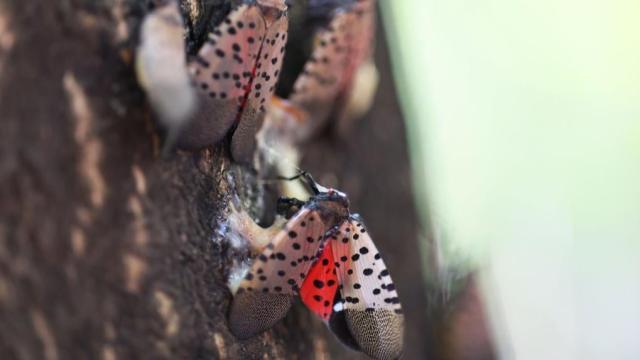You’ve heard the pleas from scientists: Squash these bugs without mercy. Entomologists and agriculture experts have been begging the public to help stop the spread of the ultra-destructive spotted lanternfly for several years now, but despite our best efforts, the invasive insect is now a familiar sight in 14 states, where it’s killing trees and crops and generally creeping people out.
Spotted lanternflies, native to China, are adept at hitching rides on vehicles to spread to new locations, and they have no natural predators in the U.S. That’s made stopping them a particular challenge, one that we seem to be failing at. Though the flashy bugs don’t harm humans directly, they drain the sap from plants and secrete a sticky substance called honeydew that can then host black fungus. A little fungus isn’t a big deal, but too much of it can engulf and smother crops and trees. Kelli Hoover, a professor of entomology at Penn State, said that the mould can spread to nearby structures, like someone’s house or outdoor deck. “It’s really hard to get off, and it’s really slippery,” she told Earther.
Since their presumed arrival in Pennsylvania in 2012, spotted lanternflies have now also been documented in New York, Delaware, Connecticut, Maryland, Indiana, Virginia, West Virginia, Rhode Island, Massachusetts, Michigan, New Jersey, North Carolina, and Ohio. “They tend to hitchhike. They are really good at jumping on, like, a railroad car and getting off at the next stop,” Hoover said. Swarms of the insects threaten apples, grapes, hops, plums, almonds, and hardwood trees, according to the USDA.
Is there any hope of stopping these invaders before they take over most of the U.S.? Scientists are trying to answer that question by learning more about the conditions, and particularly the temperatures, in which the insect can thrive. “Guessing exactly where they’re gonna go next… I don’t think anybody can,” Hoover said. “They may not do all that well as they go further south. They’re in North Carolina now. They’re doing just fine there. Could they do well in Florida or Alabama or Louisiana? I don’t know.”
Matthew Travis, national policy manager at the U.S. Department of Agriculture’s Animal and Plant Health Inspection Service (APHIS), confirmed that it is difficult to know with certainty where the spotted lanternflies are going to go. Through modelling, the agency has been able to correlate population spread and transportation pathways like interstate corridors and railroads. They’ve used this to develop strategies for reducing lanternfly populations. “APHIS is conducting targeted treatments and is removing SLF’s preferred host plant, tree of heaven, from transportation hubs in many areas,” he said in an email.
Travis explained that APHIS has found that spotted lanternfly egg masses cannot deal with cold temperatures. They’d have an especially hard time surviving in an area that has an average temperature under 57 degrees Fahrenheit (14 degrees Celsius). They would also struggle to survive in an area where average temperatures reach over 95 Fahrenheit (35 degrees Celsius), according to Travis. So though the bugs may happily harass New England, it’s not likely that we’ll find an abundance of spotted lanternflies in Northern Canada, unless they adapt to much lower average temperatures, Hoover noted.
A 2019 study in the Journal of Economic Entomology analysed potential environments for spotted lanternflies throughout the U.S. It wasn’t a prediction of where the bugs would go but an outline of the kinds of environments they could thrive in. The most suitable environments for lanternflies happen to be throughout most of the Northeast and some of the Midwest and Central states. The researchers found that farther down into Florida and Texas weren’t as suitable for the insects.
Large swaths of northwest and north central states were found to be unsuitable for the lanternflies in 2019. Some parts of the Pacific Northwest and California were found to have medium to high suitability for the lanternflies — which would put the fruit growing industries out West in peril if the insects do establish there.
Earther asked the USDA if the spotted lanternflies are on their way to becoming a permanent presence in the country, which is something that several other invasive insects have done over time. “It is too soon to predict where in the U.S. this pest will become a permanent species,” Travis wrote.
Hoover wouldn’t predict with confidence whether the spotted lanternfly takeover is now inevitable, but she did say they could be here to stay for some states. She thinks it’s worth the effort to keep spotted lanternfly populations low but said the lanternflies may win in some places. “We can keep the numbers down to a manageable level,” she said. “If I live next door to a vineyard, and I had lanternflies … I would treat my trees. If I didn’t live next to anything that was going to be harmed by it, I wouldn’t bother.”
